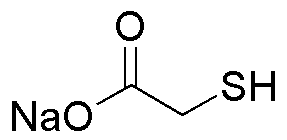Thioglycolic acid sodium salt is widely utilized in research focused on:
- Cosmetics and Personal Care: This compound is a key ingredient in hair removal products and depilatories, providing effective results by breaking down hair structure.
- Pharmaceuticals: It serves as a reducing agent in drug formulation, enhancing the stability and efficacy of certain medications, particularly in the development of topical treatments.
- Textile Industry: Used in dyeing processes, it helps in the fixation of dyes to fabrics, improving color retention and vibrancy.
- Analytical Chemistry: Thioglycolic acid sodium salt is employed in various analytical techniques, such as chromatography, to separate and identify compounds based on their reactivity.
- Metal Treatment: It acts as a chelating agent in metal finishing processes, effectively removing impurities and enhancing the quality of metal surfaces.
General Information
Properties
Safety and Regulations
Applications
Thioglycolic acid sodium salt is widely utilized in research focused on:
- Cosmetics and Personal Care: This compound is a key ingredient in hair removal products and depilatories, providing effective results by breaking down hair structure.
- Pharmaceuticals: It serves as a reducing agent in drug formulation, enhancing the stability and efficacy of certain medications, particularly in the development of topical treatments.
- Textile Industry: Used in dyeing processes, it helps in the fixation of dyes to fabrics, improving color retention and vibrancy.
- Analytical Chemistry: Thioglycolic acid sodium salt is employed in various analytical techniques, such as chromatography, to separate and identify compounds based on their reactivity.
- Metal Treatment: It acts as a chelating agent in metal finishing processes, effectively removing impurities and enhancing the quality of metal surfaces.
Documents
Safety Data Sheets (SDS)
The SDS provides comprehensive safety information on handling, storage, and disposal of the product.
Product Specification (PS)
The PS provides a comprehensive breakdown of the product’s properties, including chemical composition, physical state, purity, and storage requirements. It also details acceptable quality ranges and the product's intended applications.
Certificates of Analysis (COA)
Search for Certificates of Analysis (COA) by entering the products Lot Number. Lot and Batch Numbers can be found on a product’s label following the words ‘Lot’ or ‘Batch’.
*Catalog Number
*Lot Number
Certificates Of Origin (COO)
This COO confirms the country where the product was manufactured, and also details the materials and components used in it and whether it is derived from natural, synthetic, or other specific sources. This certificate may be required for customs, trade, and regulatory compliance.
*Catalog Number
*Lot Number
Safety Data Sheets (SDS)
The SDS provides comprehensive safety information on handling, storage, and disposal of the product.
DownloadProduct Specification (PS)
The PS provides a comprehensive breakdown of the product’s properties, including chemical composition, physical state, purity, and storage requirements. It also details acceptable quality ranges and the product's intended applications.
DownloadCertificates of Analysis (COA)
Search for Certificates of Analysis (COA) by entering the products Lot Number. Lot and Batch Numbers can be found on a product’s label following the words ‘Lot’ or ‘Batch’.
*Catalog Number
*Lot Number
Certificates Of Origin (COO)
This COO confirms the country where the product was manufactured, and also details the materials and components used in it and whether it is derived from natural, synthetic, or other specific sources. This certificate may be required for customs, trade, and regulatory compliance.


